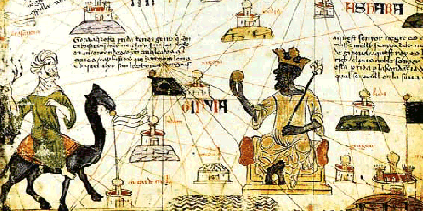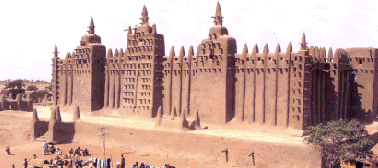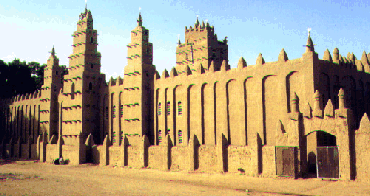

Several black civilizations emerged after the fall of KIMET ( Egypt ). In Western Africa, 3 of the most celebrated of these were the successive empires of Ghana, Mali and Songhay in the Western Sudan. The modern states of Ghana and Mali should not be confused with these medieval empires. Although many of the people of the modern nations are descended from the old Empires, it should be understood that the modern states were named after the old empires after independence from the colonial powers and are distinct entities in and of themselves.
A number of sources are used in this article. The first is "Precolonial Black Africa" by the late Cheikh Anta Diop. The first passage below is excerpted therefrom :
Ibn Battuta who visited Mali in 1351-1353, under Mansa Soleiman (Emperor of Mali), left testimony which allows us to recreate the local color of Royal audiences.
On audience days, the emperor sat in an alcove that had a door leading into the palace: it had 3 windows made of wood covered in silver foil, and below it 3 others decked with gold plate or vermeil (which leads us to believe that the palace had at least 2 stories). These windows had curtains: a handkerchief with Egyptian designs, attached to a silken cord, was slipped through the grillwork that protected them on audience days. The people were summoned by horn and drums. 300 soldiers carrying bows and javelins lined up in double columns on either side of the window in which the emperor was to be. Those with javelins were on the outside and standing, while those with the bows sat in front of them, the 4 columns facing each other. Two saddled, bridled horses and 2 rams were brought in: a custom reminescent of Ghana. Nearly 300 subjects went looking for Candja Mussa. The Ferraris, the Emirs, the preacher (khatib), and the jurists arrived and took seats, to the right and left in front of the soldiers, in the space between their columns. Dugha the herald, stood at the door, wearing Zerdkhahan clothes: on his head a fringed turban, typical of the country: he alone had the priviledge of wearing boots on this day; He had a sword in a gold scabbard on his side; and he wore spurs, two gold and silver javelins with iron tips.Soldiers, bureaucrats, pages, Messufites, and all others, remained outside, in a wide treelined street. Each of the ferraris was preceded by his subordinates carrying blades, bows, drums, and horns made of elephant tusks. ......
When in October 1559 Askia Daud defeated the Mansa of Mali, at the battle of Dibikarala, he married his daughter Nara; she then lived in luxury comparable to Helen of Troy. She was covered with jewels, surrounded by numerous slaves, both male and female, and abundantly supplied with furniture and baggage. All of her household utensils were made of gold: dishes, jars, mortars, pestles, and so on.
Obviously, an illustration of African history is possible: there are more documents than generally stated. They allow us to reconstitute, sometimes even in detail, over a period of almost 2000 years, African political and social life. We know how members of the different classes in Ghana, Mali, Songhai, and Cayor were dressed; what they did with their spare time, their daily routines, and so on. We know what social relationships governed society, and thus the behavior of an entire society which we can vividly bring back to life before our eyes, even on the stage or in films. The local color would be authentic.
Political Organization
We must know the actual power and extent of the African Empires. These factors are often minimized, or left vague. Insofar as there exists a certain persistent tendency to allude to more or less mythical white conquerors to explain African civilizations, it is worthwhile to re-establish the truth strictly based on facts and documents...... The boundaries of the Empire of Mali stretched from Kaoga (Gao) all the way to the Atlantic and from the Sahara to the tropical forest. According to Ibn Khaldun, the Emperor of Mali reigned over the entire Sahara:"...Mansa mussa was a powerful sovereign whose authority extended as far as the desert near Uargla."...... Africans were already in the habit of traveling to North Africa, and sometimes settling there to study. Mali's international activity thus incresed. Delafosse was quite right to be impressed by the might of this nation: Meanwhile, Gao had recovered it's independence between the death of Gongo (Kankan) Mussa and the accension of Suleiman Mansa, and approximately one century later, the Mandingo empire began to decline under the attacks of Songhai, while preserving enough power and prestige so that its sovereign could meet on equal footing with the King of Portugal, then at the height of its glory.

The might of the empire was such that the Arabs sometimes called on it for military aid. Such was the case, according to Khaldun, of El Mamer, who fought the Arabo-Berber tribes in the Northern Sahara. He appealed to Kankan Mussa, on the latter's return from Mecca, to come to his aid militarily. Khaldun also tells of the size of the Morroccan embassy in Mali and the interest the Sultan of Morrocco displayed in it:
The Maghreban sultan even had prepared a selection of the finest products of his realm and entrusted to Ali Ibn-Ghanem, Emir of the Makil, the task of transporting this truly royal gift to the sultan of the Blacks. A deputation made up of the highest-ranking individuals in the empire accompanied Ibn-Ghanem.
Contrary to the notions prevailing today, the relationship then existing between whites and blacks could not have been those of masters to slaves. A passage from Ibn Battuta, who visited that very empire of Mali, clearly reveals the state of mind and the pride of Africans of this period ( 1352 ). The border regions of the Empire, such as Ualata, at the edge of the Sahara, were governed by black Farbas who levied customs duties and other taxes on caracans bringing merchandise into the country. Upon arrival, the merchants had to clear administrative formalities with them, before being allowed to continue their trade...... The white minorities who lived in the Empire at the time of Ghana were now, in even greater numbers, under the rule of Mali: "In these regions, there is no one deserving the name of king, unless it be the sovereign of Ghanah, who is a kind of viceroy of the emperor of Mali, although in his own domain, he is like a veritable king. To the north of Mali, there are white Berbers who live as his subjects. These are the Yantasar, Yantafras, Maddusah, and the Yantasar who have their own kings, vassals of the Emperor of Mali."
Military Organization :
In Mali and Songhai, we know for certain, the king who appointed the generals was himself the commander in chief of the army and personally directed military operations, ...In each aech kingdom, each nation, the army was devided into several corps assigned to the defanse of different provinces, although under command of the civil authority. Thus, each perovincial governor had at his disposal a part of this army to which he could assign tasks under the orders of a general whose power were purely military. On the lower level, below the king, in political or administrative affairs, the distinction between civil and military powers was thus very clear. The king of Mali, when he conquered Songhai, Timbuktu, Zagha, Mima, the Baghena, and the environs of that region as far as the Atlantic Ocean, had two generals under his command. One was responsible for the defense of the southern part of the empire on the Mossi border, the other of the nothern part at the edge of the desert. Their respective names were Sankar-Zuma and Faran-Sura......The western borders of the state of Djenne, before the conquest of the city by Sonni Ali, were defended by the commanders oftwelve army corps deployed in the country of Sana.
Knights
The princes of Black Africa who could afford to outfitted themselves in complete or partial armor like that of the knights of the Western Middle Ages. When balama Mohammed es-Sadek revolted against Askia Mohammed Bano and in March 1588 attempted to march on Kaoga, the Askia who came forth to challenge him wore an iron breastplate. As it was extremely hot and the Askia was very fat, he died of the effects of his armor. The rebellous balama wore an iron helmet; when Omar Kato threw a javelin at his head, it ricocheted off the helmet. Another sultan of Morrocco, Mulay Ahmed, in December 1589 - January 1590, renewed the request made by one of his predecessors about the mines of the Teghezza. shaq II, who was then Askia, reacted violently, and as a sign of defiance and a show of force sent the sultan an offensive letter, some javelins, and 2 iron boots.
The University
As in the Western Middle Ages, teaching was in the hands of the clergy
which, in the case of West Africa, was Mohammedan. Documents at our
disposal now permit us to describe in detail the intellectual life of the
University, particularly that of Sankore, in Timbuktu. The student body
was made up of all those who, regardless of age, were possesed of an
insatiable thirst for knowledge. Today, it is difficult for us to picture the
extent of this need among Africans of this period. The mosque was at one
and the same time also the place of learning, the university....
But what actually was the program ? Recollection of the 7 Arts never
altogether vanished in Europe, but it was the Arabs who introduced the
Aristotlean texts to it, well before the Crusaders' contact with Byzantium.
They introduced the same texts into Black Africa in the same period. The
trivium, i.e., the studdy of grammar, Aristotlean logic ( formal logic,
grammatical logic ), and rhetoric, was on the list of subjects taught, as
shown in the Tarikh es Sudan. capter X of the work gives the biographies
of seventeen scholars of Timbuktu, indicating all the subjects they had
mastered. Almost all of them were dialecticians, rhetoricians, jurists etc.
One of them, the famous Ahmed Baba, is said to have left more than 700
works. Each one of them also had an immense library, also lost to us
today.......
In the middle ages, 400 years before Levy-Bruhl wrote his Primitive
Mentality, Muslim Black Africa was already commenting on Aristotle's "
formal logic" and practicing dialectics.

Crime:
According to Ibn Batuta, the roeds in the interior of Africa were absolutely safe: "Having decided to visit the latter city ( Mali ), I hired but one Messufite to serve as my guide since there is no need to travel by carravan, for the roads are that secure...">>
-------------------------------------------------------------------------------
<
------------------------------------------------------------------------------------------------
<
A number of important points must be made regarding African history:
Firstly, the pervading myth that Sub -Saharan Africa produced no
writing is clearly false. Not only were documents produced in Arabic ,
which was the language of the universities and of international commerce
at the time, but Afrikans produced a number of indigenous scripts of their
own.
Molefi Kete Asante points out in African Intellectual Heritage: A Book of
Sources:
--------------------------------------------------------
<
2. The complete and general safety one enjoys throughout the land. The
travaler has no more reason to fear brigands thieves, or ravishers than the
man who stays at home.
3. The blacks do not confiscate the goods of the white man (i.e. of North
Africans ) who die ion their country, not even when these consist of big
treasures. They deposit them, on the contrary, with a man of confidence
among the whites until those who have a right to the goods present themselves and take possesion.>> 
From The Origin and Growth of Afro-American Literature by John Henricke Clarke: